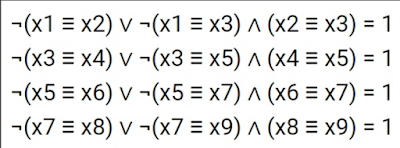Denote by DEL (n, m) the statement "a natural number n is divided without a remainder by a positive integer m". For what is the smallest natural number A, the formula
(D(34)⊕D(51) => ¬D(A)^D(272)) v Е(15) ≡ 1
is identically true (that is, it takes the value 1 for any natural value of the variable x)?
First notice belongs to Helen :-
D(16) = ¬E(1)*¬E(2)*¬E(4)*¬E(8) =
= ¬(E(1) v E(2) v E(4) v E(8)) = ¬E(15)
E(16)=¬D(16)
Convert original equation from implication to disjunction
(D(34)≡D(51)) v ¬D(A)^D(272)) v ¬D(16) ≡ 1
D(34)^D(51) v ¬D(34)^¬D(51) v ¬D(A)^D(272)) v ¬D(16) ≡ 1
D(34)^D(51) v ¬D(34)^¬D(51) v ¬D(A)^D(17)^D(16) v ¬D(16) ≡ 1
Supress D(17) in first and fourth terms via ¬D(17),
then supress D(2^4) via ¬D(2^4) in fourth term
D(34) = D(2)^D(17)
D(51) = D(3)^D(17)
D(31)*D(51) = D(2)^D(3)^D(17)
¬D(34) = (¬D(2) v ¬D(17))
¬D(51) = (¬D(3) v ¬D(17))
¬D(34)*¬D(34) = ¬D(2)*¬D(3) v ¬D(17)
D(2)^D(3)^D(17) v ¬D(2)^¬D(3) v ¬D(17) v
v ¬D(A)^D(17)^D(2^4) v ¬D(2^4) ≡ 1
D(6) v ¬D(2)^¬D(3) v ¬D(17) v ¬D(A) v ¬D(2^4) ≡ 1
Thus A(min) = 6
Refences
1. A.
Mironchik, ALGEBRA OF PREDICATES AND RELATED GEOMETRIC MODELS CREATION IN REGARDS OF UNIFIED STATE
EXAMINATION IN INFORMATICS (RUSSIAN EGE) ,
Informatics at school №3 , 2019



